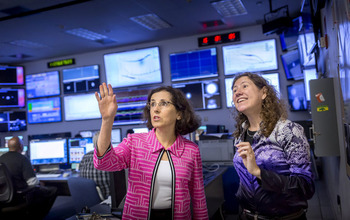
Research News
NSF Director shares her thoughts on Women’s History Month
March 3, 2016
The following is a post from Notes from the Field, the blog of NSF Director France Córdova.
This month we recognize and honor the many achievements of women scientists and engineers in celebration of Women’s History Month. The National Science Foundation (NSF) was founded in the aftermath of a world war, one that brought women into the workplace in far greater numbers than ever before. They helped win the war even as they broke a cultural barrier, demonstrating women could succeed and prosper in a workforce previously dominated by men.
We’ve come a long way since those Rosie the Riveter days, especially in science, technology, engineering and mathematics (STEM). Women have earned about 50 percent of all science and engineering bachelor’s degrees since the late 1990s. Women’s share of full-time, full professorships has more than doubled since 1993. NSF programs like ADVANCE (Increasing the Participation and Advancement of Women in Academic Science and Engineering Careers) — which works at an institutional level to support women in STEM careers — have helped spark large-scale comprehensive change and institutional transformation.
Despite advances in overall STEM degrees, women are still vastly underrepresented in fields like physics and engineering; the number of women receiving a bachelor’s degree in computer science has actually declined since 2002. This spills over into disparities in employment and even salary: In 2013, median salaries were highest for those with doctorates in computer and information sciences and engineering, fields in which men outnumber women substantially.
To close these gaps, we must promote gender diversity in STEM education, and support women every step along their path to a science or engineering career. And we must get more girls excited about STEM. Every child has a moment when their imagination is sparked by science and engineering. Watching Neil Armstrong and Buzz Aldrin step onto the moon was that moment for me — it was a reminder of my early, innate interest in science and space.
Imagine if we could keep that spark alive and nurture it. We would have a new generation of scientists and engineers, a new STEM-savvy generation. NSF funds many great programs that target young women and girls, from after-school robot programming classes to award-winning television shows. A new NSF initiative, called INCLUDES (Inclusion across the Nation of Communities of Learners of Underrepresented Discoverers in Engineering and Science), will help expand work like this, bringing more girls, women, minorities and other underrepresented groups into STEM.
This month, we’ll be sharing stories of women in STEM on NSF platforms. I want to thank the countless women who work tirelessly in science and engineering, who take risks and make discoveries and inspire others. I often give similar advice to students and young scientists across the U.S.: Be confident in your journey. In my career, I’ve had to take some calculated risks and depart from the path of others to remain true to my own scientific vision. It’s important to understand the work of people who came before you, but also dare to write history for those who will follow.
—
Jessica Arriens,
(703) 292-2243 jarriens@nsf.gov






